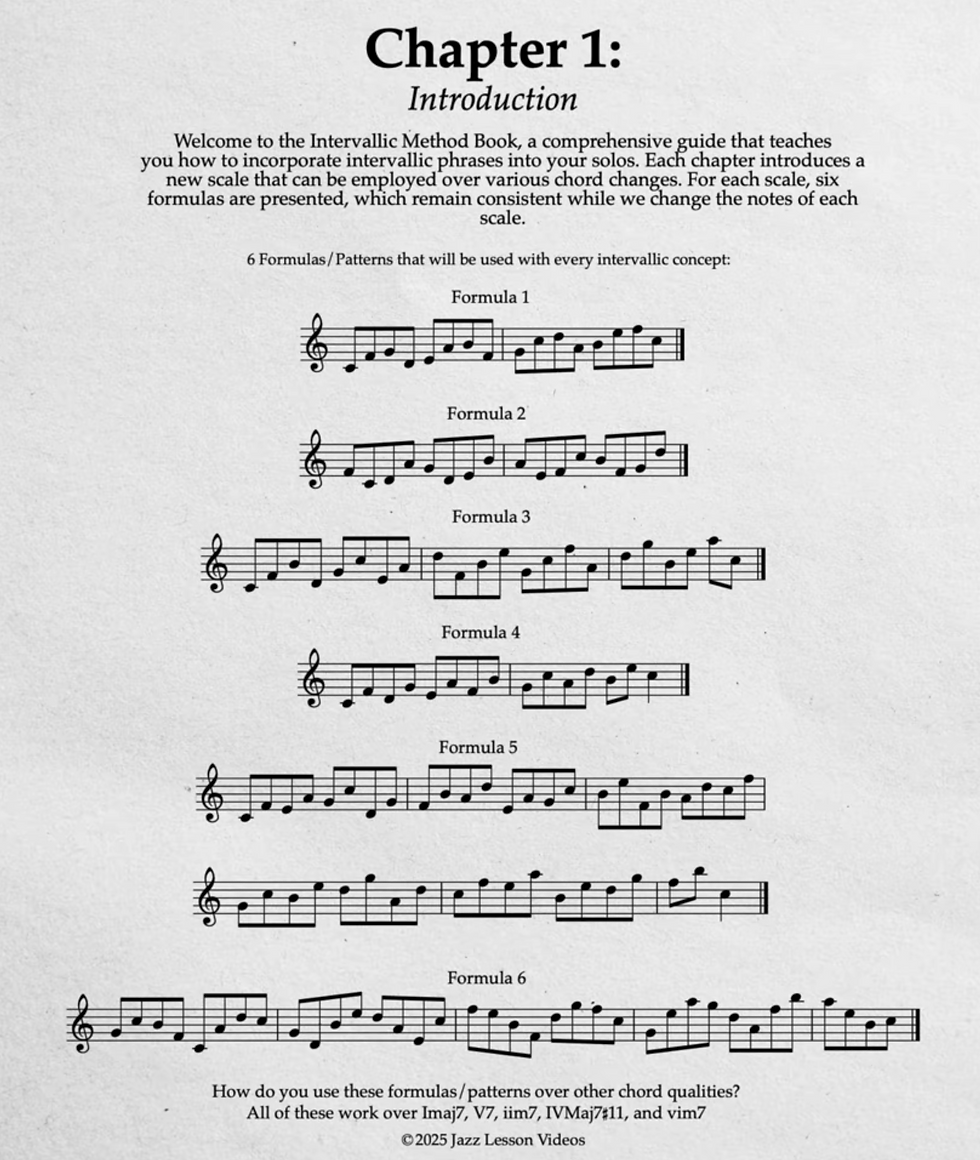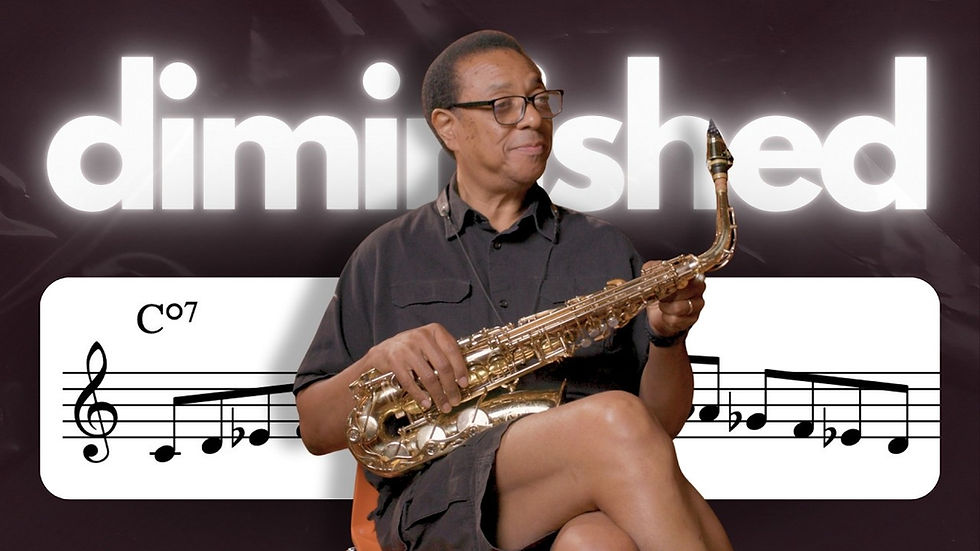How to Sound Modern in 10 Minutes
- Jazz Lesson Videos

- 6 days ago
- 5 min read
Today we’re going to be breaking down some of Ryan’s favorite ways to practice and apply large intervals into our lines.
One of the easiest ways to sound more modern is to add intervals larger than a third into your lines, even something as simple as playing a major scale in diatonic fourths can sound really hip.
Players like Chris Potter and Eddie Harris are both masters of taking simple diatonic ideas and making them sound fresh and unpredictable with these large intervals. This completely changed the way that Ryan approached improvising.
Let’s break down some different ways to add these large intervals into your practice, playing, and performance. All of the content that we’re going to cover today comes from Ryan’s method book with Jazz Lesson Videos called The Interval Method Book. This book is a step-by-step system to help you bring this modern intervallic language into your own playing. In this book, you'll find a ton of material covering how to practice, implement, and perform with large intervals, including over 50 written-out and fully analyzed lines in all 12 keys.
There are minor and major scale diatonic fourth ideas to practice in all 12 keys, intervallic shifting ideas over major and minor ii-Vs, diatonic interval ideas over major and minor ii-Vs, and there's multiple fill-in-the blank exercises to teach you how to build your own versions of these formulas.
If you want to hear Ryan play through any of the examples we cover today, make sure to check out our accompanying YouTube video, How to Sound Modern in 10 Minutes feat. Ryan Devlin.
Now let's dive in and add some of these large intervals into our lines!
Contents
Modern playing formulas
Before we get into concept number one, let’s look at what Ryan calls formulas. We have six formulas that go through—these formulas are all based on large interval lines.
In the first chapter, we have them off of our major scale, and it's laid out in all 12 keys for you. But let's go over the way that Ryan conceptualizes these six formulas.

The first formula is mainly fourths with some connecting seconds. The second formula is like the inverse of the first formula. The third formula is stacked fourths in groups of three. The fourth formula is diatonic fourths going up and down off of every scale tone. The fifth formula is a similar idea to formula number four, but with a connecting minor second in between the fourths. Formula six is more of a free improvised pattern that Ryan came up with when he was improvising—it has a fourth at the beginning, a step down, and then another fourth down, and then another fourth down. So a combination of a few of the other formulas put into one.
Let’s try applying these formulas.

We'll take formula number three, play it in C major, and we’ll talk about how this pattern can be applied to a major scale vamp, minor chord vamp, or even a ii-V-I.
This formula is really cool. The faster that you play it, the less it even sounds like a major scale. Playing over C major definitely works. You can play this over F major as well. You can also play this over G7 or you can play this over Dm too. You can play this over Em7, over Am7, and in a ii-V-I, you can play this over Dm, G7, C, or its relative minor, B m7b5, E7alt to Am.
Major ii-V-Is and Intervallic Shifting
For concept number two, we're going to be taking some ideas on major ii-V-Is, and also start to cover intervallic shifting, which is very similar to pentatonic shifting but a little bit different.
We're going to take formula number two and put this over a diatonic ii-V-I to C major.

This is a great way of practicing diatonic voice leading, while kind of disguising what we're doing. It doesn't sound like we're playing a major scale formula. Really, all we're playing is a G7 or C major line over the entire ii-V-I, but your ear hears those intervals first and doesn't necessarily hear the content of what scale you're playing.
To grow an even bigger command on the harmony, we can implement this concept called intervallic shifting, where we take the same formula and we play it through a whole ii-V-I, then halfway through, we shift to a different scale.
Looking at formula number one from our intervallic shifting section of the ii-V-I chapter, we have a bar of G7 or C major formula, a bar of Ab7 continuing the formula, and then resolving back to G7 or C major.
What's really cool about this concept is that we can shift to a lot of different tonalities that are not inside of our major ii-V-I key. You can go up a tritone, you can go down a major third, you can go down a half step. And in the book, we have different ways of intervallic shifting, while keeping that same formula.
This works because it's almost like your ear is predicting what the pattern is going to continue to be, but you shift up harmonically, and it's hard to focus on exactly what you're playing. It’s a cool way of adding a different layer of tension and release to your lines. You're not just adding tension harmonically, you're adding tension because the formula is still being continued in a way that’s not expected.
Practicing this with all six formulas in this book will give you a really great command of tension and release, while also adding those large intervals into your playing and making your own versions of these really hip lines.
Build your own formulas
Now we're going to talk about how you can start building your own formulas and own practice plan for adding these intervallic patterns into your playing.
In chapter five of our resource, we have examples called fill in the blank. It's basically a way of showing you how to build your own formulas of these large interval phrases.
We’ll look at a pattern in the key of C that's written in this fill in the blank exercise.

The goal here is to try and make your own versions of these lines. You can keep the pattern the same, or you can improvise off of these patterns too.
Here’s “Softly As In a Morning Sunrise,” but including blanks for you to fill in. Try using some of the patterns in this!

That’s all for today, but if you’re interested in diving even deeper, make sure to check out our accompanying YouTube video “How to Sound Modern in 10 Minutes feat. Ryan Devlin,” as well as our resource The Interval Method Book.
We’ll see you next time!



Comments